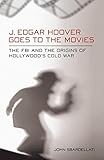J. Edgar Hoover Goes to the Movies : The FBI and the Origins of Hollywood's Cold War / John Sbardellati.
Material type: TextPublisher: Ithaca, NY : Cornell University Press, [2012]Copyright date: 2012Description: 1 online resource (264 p.) : 10 halftonesContent type:
TextPublisher: Ithaca, NY : Cornell University Press, [2012]Copyright date: 2012Description: 1 online resource (264 p.) : 10 halftonesContent type: - 9780801464218
- Cold War in motion pictures
- Cold War -- Social aspects -- United States
- Cold War -- Social aspects -- United States
- Communism and motion pictures -- United States
- Communism and motion pictures -- United States
- Motion pictures -- Political aspects -- History -- United States
- Motion pictures -- Political aspects -- United States -- History
- Film
- U.S. History
- PERFORMING ARTS / Film & Video / History & Criticism
- motion picture industry, film history, it's a wonderful life, the grapes of wrath, the best years of our lives, crossfire, on the waterfront, film and political ideology, hollywood's history, film criticism, film and national security
- 384.8097309045 23
- PN1995.9.P6 S26 2016
- online - DeGruyter
| Item type | Current library | Call number | URL | Status | Notes | Barcode | |
|---|---|---|---|---|---|---|---|
 eBook
eBook
|
Biblioteca "Angelicum" Pont. Univ. S.Tommaso d'Aquino Nuvola online | online - DeGruyter (Browse shelf(Opens below)) | Online access | Not for loan (Accesso limitato) | Accesso per gli utenti autorizzati / Access for authorized users | (dgr)9780801464218 |
Frontmatter -- Contents -- Acknowledgments -- Introduction: Hollywood’s Red Scare -- 1. A Movie Problem -- 2. The FBI’s Search for Communist Propaganda during the Second World War -- 3. Producing Hollywood’s Cold War -- 4. The Coalescence of a Countersubversive Network -- 5. The 1947 HUAC Trials -- 6. Rollback -- Conclusion: Three Perspectives on the Death of the Social Problem Film -- Appendix: Analysis of Motion Pictures Containing Propaganda: An FBI Filmography of Suspect Movies -- Notes -- Index
restricted access online access with authorization star
http://purl.org/coar/access_right/c_16ec
Between 1942 and 1958, J. Edgar Hoover’s Federal Bureau of Investigation conducted a sweeping and sustained investigation of the motion picture industry to expose Hollywood’s alleged subversion of "the American Way" through its depiction of social problems, class differences, and alternative political ideologies. FBI informants (their names still redacted today) reported to Hoover’s G-men on screenplays and screenings of such films as Frank Capra’s It’s a Wonderful Life (1946), noting that "this picture deliberately maligned the upper class attempting to show that people who had money were mean and despicable characters." The FBI’s anxiety over this film was not unique; it extended to a wide range of popular and critical successes, including The Grapes of Wrath (1940), The Best Years of Our Lives (1946), Crossfire (1947) and On the Waterfront (1954).In J. Edgar Hoover Goes to the Movies, John Sbardellati provides a new consideration of Hollywood’s history and the post–World War II Red Scare. In addition to governmental intrusion into the creative process, he details the efforts of left-wing filmmakers to use the medium to bring social problems to light and the campaigns of their colleagues on the political right, through such organizations as the Motion Picture Alliance for the Preservation of American Ideals, to prevent dissemination of "un-American" ideas and beliefs. Sbardellati argues that the attack on Hollywood drew its motivation from a sincerely held fear that film content endangered national security by fostering a culture that would be at best apathetic to the Cold War struggle, or, at its worst, conducive to communism at home. Those who took part in Hollywood’s Cold War struggle, whether on the left or right, shared one common trait: a belief that the movies could serve as engines for social change. This strongly held assumption explains why the stakes were so high and, ultimately, why Hollywood became one of the most important ideological battlegrounds of the Cold War.
Mode of access: Internet via World Wide Web.
In English.
Description based on online resource; title from PDF title page (publisher's Web site, viewed 26. Aug 2024)


